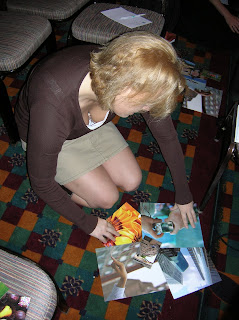Not A Routine. Not A Habit
I have a lovely little book by Michael Davis called, "Rituals". It is a treasure trove full of ideas about why we have rituals, and it clearly explains the difference between a routine, a tradition and a ritual.
A routine is something we do without thinking. Like brushing our teeth in morning, or pouring a cup of coffee before we answer emails.
A tradition is a ritual that has been transferred from generation to generation. Like making certain cookies at Christmas time, or spending summers at the beach.
Rituals are a way of defining what is meaningful and important. Ok, granted - brushing your teeth is important, but the value of a ritual comes from "its ability to connect you to a larger context that clarifies your relationship to yourself, others and your place in the universe."
I have found that rituals have a way of marking important passages of time. Birthdays are a favorite ritual of mine and a very significant marker of time. Rituals also help with closing one chapter of life and the beginning of something new.
Rituals are vital in the process of change.
It is easy to get lost in the middle part of transformation, where one thing has ended and we are waiting for the new beginning.
Celebrate & Mourn : Demarcate
I've recently experienced two very important rituals in my life, both very different events and both equally important for me and others to go through.
Loss
In August of last year I attended the memorial service of my father.
I listened - with my mother, two sisters, daughter, and many friends - to kind words of a strange minister, generous words from a family friend, bird song - while the photo of my father as a young man in uniform smiled back at us. I cried, although I tried not to. The first part of the ritual.
I jumped when they fired the guns - all three times. It was shocking. The second part of the ritual.
Then I walked over to where the urn would be buried, marked with a simple white wooden cross (which is what they use in a military cemetery). And I looked up at the amazing view of the mountains and trees in the back drop of Alaska. It was so beautiful and it made me feel calm. The third part of the ritual.
Birth
Now, this isn't the kind of birth you are thinking of perhaps. No trips to the hospital, no blood. However, there was anxiety, fear, butterflies, tears, and excitement. There was also a waiting period. A little more than a year after selling my house, car, closing all of my bank accounts, credit cards, and insurance policies and closing my business - after moving to Germany - I celebrated the birth of my new company.
Yup, I threw a party complete with fun food, music, videos, processo, speeches and games. I needed to mark this beginning. To thank everyone who had helped me get to this point, to acknowledge I was at the start of something new. I needed to do it for my own recognition and I needed to do it to make this company concrete.
I needed to make a mark in time, because then I'd have something to look back on. Something to remind myself - look, see how far you've come!
How do you mark time? What are your rituals?
If you find yourself saying, "Um, I can't think of any." or "I don't have any - I don't have time for that." then you are like many -- a casualty of the modern world.
Getting Rituals Back Into Your Life
First, you must recognize that there is a significant or meaningful event in your life. What is significant? You decide - it is as simple as that.
Second, gather materials with meaning to you and that represent the event. A candle, music, a rock, a picture, a scent.
Third, find a quite place, or gather people around you and prepare to say something, whether it is to yourself or to the crowd. Talk about the past, the present, your hope for the future. Touch on an emotion - gratitude, anticipation, anxiety, joy.
Invite others to share their hopes, joy for you. Or simply be quiet and listen to the wind in the trees. Be present.
In the end, mark the closing of the event with a sound (a chime, clinking of glasses, song), light a candle, blow one out - do whatever signifies a closing in your mind. It may be a closing of a chapter of your life, or the beginning of something new - like mine.
So- what are YOUR rituals?

















































